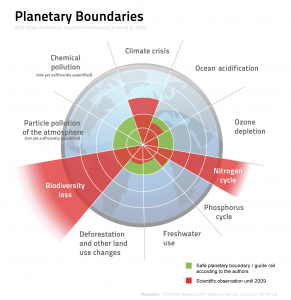Focusing exclusively on cutting CO2 emissions will only address part of the problem.
“We need a more comprehensive approach for assessing and guiding humanity’s environmental impact.”
.
There are ‘boundaries’ for any system – and once they are crossed, then that shows we have left safety and are in dangerous territory.
The idea of ‘planetary boundaries’ was developed in 2009 by a group of Earth system and environmental scientists who wanted to define a “safe operating space for humanity”:
Planetary boundaries – Wikipedia
.
The team is based in Sweden:
The nine planetary boundaries – Stockholm Resilience Centre
.
This is from a piece on the Engineering and Technology website:
.
 Planetary Boundaries: it’s not just about the carbon emissions
Planetary Boundaries: it’s not just about the carbon emissions
The effects of carbon emissions are well known, yet scientists argue we need a more comprehensive approach for assessing and guiding humanity’s environmental impact. We investigate how the concept of ‘Planetary Boundaries’ could inform how engineers work.
When Covid-19 lockdowns were announced earlier this year, the global economy ground to a painful halt. However, one unintended beneficiary was the environment. Carbon emissions plummeted, air pollution dissipated, usually murky rivers ran clear and there were countless good news stories from all over the world of resurgent wildlife.
Since the beginning of the industrial revolution, human development has been predicated on a philosophy of unlimited growth. However, it is becoming increasingly clear that ‘unlimited’ growth has plenty of downsides. When industry wreaks havoc on the natural world it, in turn, causes a variety of extreme environmental events, which undermine human development – from floods to fires to collapses in populations of pollinators like bees that are vital to agriculture.
At present, most efforts around environmental policy go into reducing greenhouse gas emissions. This is a start, yet it fails to consider the many other ways that humanity is damaging the environment – from ocean acidification to land use. Focusing exclusively on cutting CO2 emissions will only address part of the problem.
This is where a more comprehensive scientific model, known as Planetary Boundaries, could be useful. First described in 2009 by a group of environmental scientists, it lists nine ‘planetary boundaries’ – limits on damage to the Earth’s natural systems beyond which catastrophe becomes increasingly likely. How could it be applied?
…
Planetary Boundaries: it’s not just about the carbon emissions | E&T Magazine
.
The idea is very much in the news:
Can the planetary boundaries framework be applied to the human use of materials? | Greenbiz
.
We must transform our food systems so that enough healthy and nutritious food is produced for all, within planetary boundaries. Presently, the way we produce and consume food is the biggest driver of biodiversity loss, land and water use, deforestation and conversion, producing around a quarter of all greenhouse gas emissions. The good news is that there are huge opportunities to feed the world in a way that works with nature, not against it.
COVID shows what happens when we destroy nature – that must change
.
Companies do not exist in a vacuum. In our view, business leaders will increasingly need to view their role — indeed, their future survival — through these planetary and societal lenses. This has become obvious after nearly six decades of corporate development, predicated in large part on natural resource exploitation — where, as the planetary boundaries teach us, we are nearing many tipping points.
What Does It Really Mean to Call ‘Society’ Your Stakeholder? – Sustainable Brands
.
Our economy lives by overshooting our planetary boundaries, adopting a predatory and unrestrained approach that is killing our shared home. Enough with naivety and poetry, going back to the soil is a political issue. “The soil is low,” says an old farmer’s proverb: It means that to get connected with it, we must bend down to gather and safekeep its heritage.
Here’s what the future of circular food looks like | Greenbiz
.